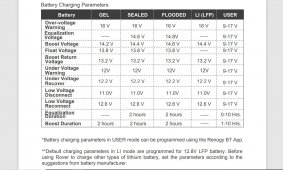Ed Tech Sensei
New Member
- Joined
- Apr 3, 2021
- Messages
- 49
Here is my setup. BougeRV 12v, 180 watt solar panel, Giandel 1200w/2400w PSW inverter, Renogy Rover 40 amp MPPT solar charge controller, Battery Evo 120Ah battery X 2 in parallel. Renogy SCC will take 8 awg or smaller. 8 awg from Renogy to Giandel inverter. Anderson SB175, 6 awg from battery to Anderson SB50. SB50 8 awg cable to Renogy SCC. Connections are solid and tight.
Charged the batteries to 14.4 volts with 110 watts from the solar panel. No problem. Placed a 220 watt load on the inverter, monitored with a Kill-a-Watt meter. No problem. Placed a 470 watt load on the inverter with a heat gun. Inverter shut down after 5 seconds with a low battery warning. Both the Renogy and the Battery Evo display showed 13.7 volts.
Disconnected the solar panel from the Renogy. Disconnected the batteries from the Renogy. Connected batteries directly to the inverter. Placed the 220 watt load on the inverter (lights and a fan). No problem. Placed a 470 watt load on the inverter (heat gun.) No problem. Bumped the heat gun to HIGH pulling 1099 watts. No problem.
I think the discharge cutoff voltage for the Renogy is set too high. The spec sheet shows discharge cutoff voltage is greater than or equal to 10V but that doesn't make sense. Shouldn't it be less than or equal to?

Charged the batteries to 14.4 volts with 110 watts from the solar panel. No problem. Placed a 220 watt load on the inverter, monitored with a Kill-a-Watt meter. No problem. Placed a 470 watt load on the inverter with a heat gun. Inverter shut down after 5 seconds with a low battery warning. Both the Renogy and the Battery Evo display showed 13.7 volts.
Disconnected the solar panel from the Renogy. Disconnected the batteries from the Renogy. Connected batteries directly to the inverter. Placed the 220 watt load on the inverter (lights and a fan). No problem. Placed a 470 watt load on the inverter (heat gun.) No problem. Bumped the heat gun to HIGH pulling 1099 watts. No problem.
I think the discharge cutoff voltage for the Renogy is set too high. The spec sheet shows discharge cutoff voltage is greater than or equal to 10V but that doesn't make sense. Shouldn't it be less than or equal to?







